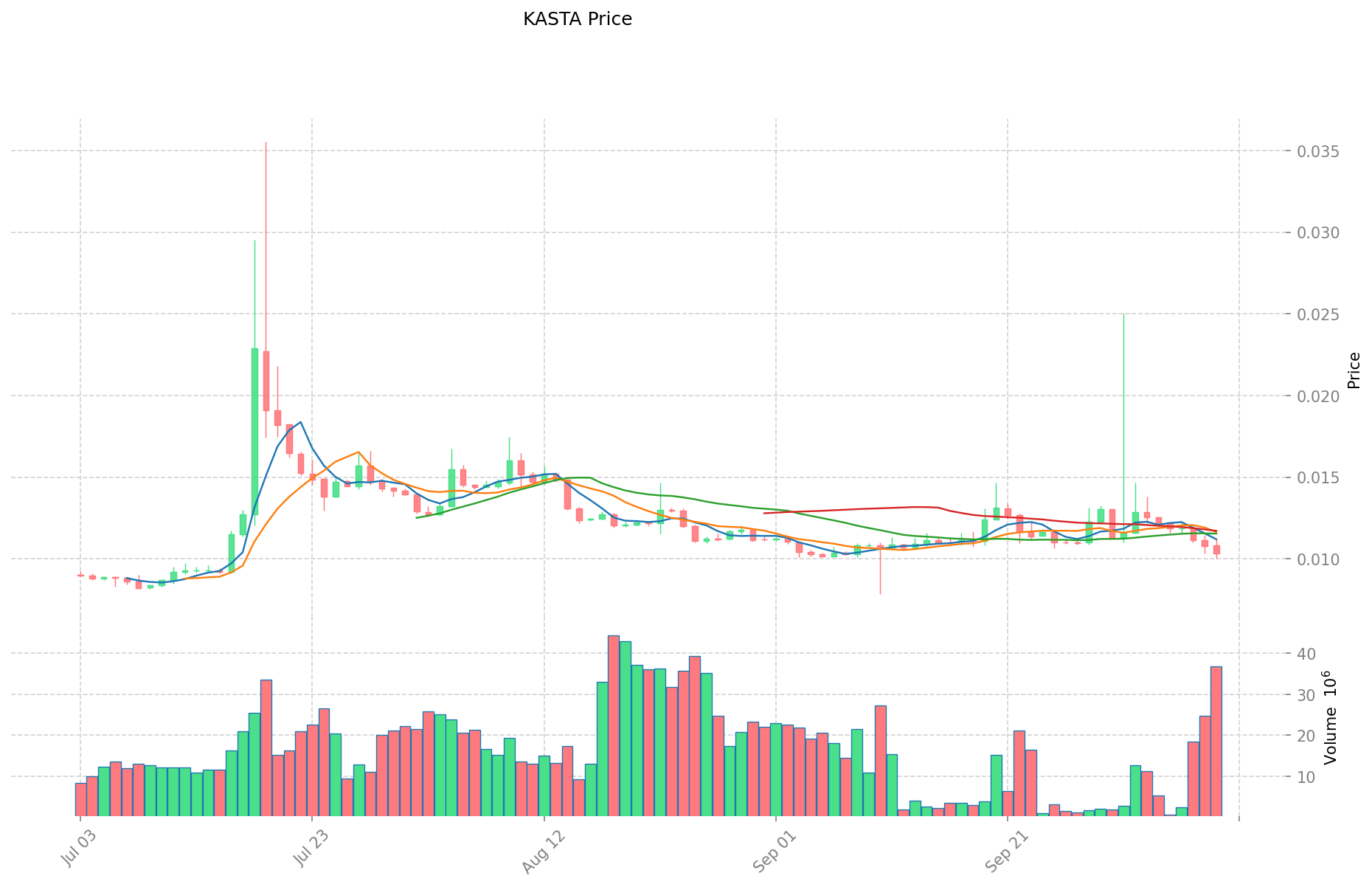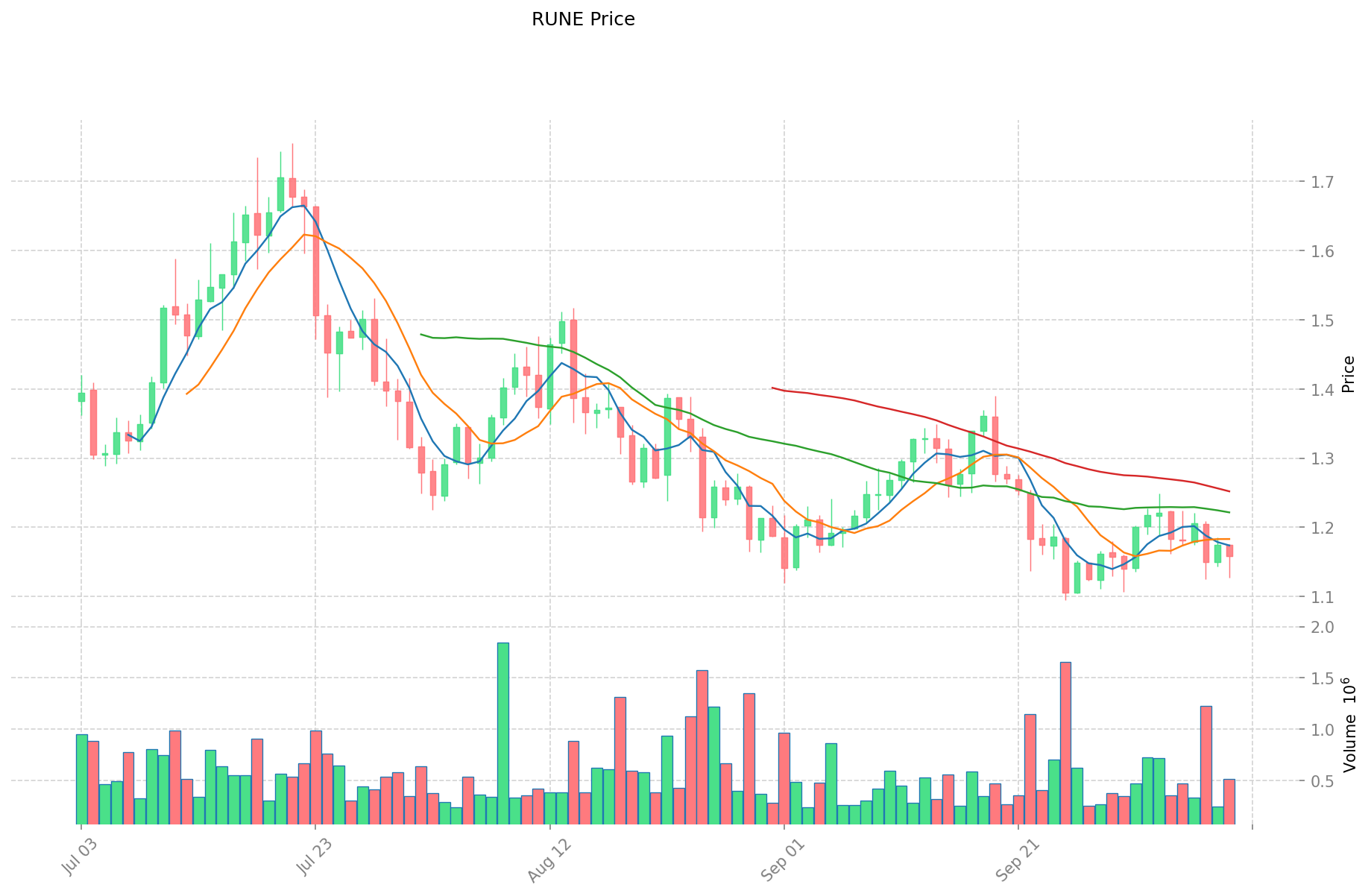KASTA vs RUNE: Comparing Two Emerging Blockchain Platforms for Cross-Chain Asset Transfers
Introduction: KASTA vs RUNE Investment Comparison
In the cryptocurrency market, the comparison between Kasta vs RUNE has been an unavoidable topic for investors. The two not only differ significantly in market cap ranking, application scenarios, and price performance, but also represent different positioning in the crypto asset space.
Kasta (KASTA): Since its launch in 2022, it has gained market recognition for its encrypted payment platform enabling instant and borderless transactions.
RUNE (RUNE): Introduced in 2019, it has been hailed as the native token of THORChain, a highly optimized multi-chain ecosystem.
This article will comprehensively analyze the investment value comparison between Kasta and RUNE, focusing on historical price trends, supply mechanisms, institutional adoption, technical ecosystems, and future predictions, attempting to answer the question investors care about most:
"Which is the better buy right now?"
I. Price History Comparison and Current Market Status
KASTA (Coin A) and RUNE (Coin B) Historical Price Trends
- 2022: KASTA reached its all-time high of $1.13 on January 6, 2022.
- 2021: RUNE reached its all-time high of $20.87 on May 19, 2021.
- Comparative analysis: KASTA has fallen from its all-time high of $1.13 to a current price of $0.01029, while RUNE has dropped from its peak of $20.87 to $1.1588.
Current Market Situation (2025-10-10)
- KASTA current price: $0.01029
- RUNE current price: $1.1588
- 24-hour trading volume: KASTA $392,749.73 vs RUNE $595,956.09
- Market Sentiment Index (Fear & Greed Index): 70 (Greed)
Click to view real-time prices:
- View KASTA current price Market Price
- View RUNE current price Market Price


II. Core Factors Affecting the Investment Value of KASTA vs RUNE
Supply Mechanism Comparison (Tokenomics)
- KASTA: Fixed maximum supply of 1,500,000,000 KASTA tokens with programmatic distribution across platform development, team, investors, and ecosystem growth
- RUNE: Deflationary model with continuous emissions reduction and burn mechanism through protocol fees, with an initial target supply of 500,000,000 RUNE
- 📌 Historical pattern: Limited supply assets like RUNE tend to experience more price volatility during bull markets, while KASTA's larger but fixed supply aims for more gradual appreciation tied to adoption metrics.
Institutional Adoption and Market Applications
- Institutional holdings: RUNE has attracted greater institutional interest through its DeFi infrastructure positioning and capital efficiency model
- Enterprise adoption: KASTA focuses on payment solutions and user-friendly financial services, while RUNE serves as critical infrastructure for cross-chain liquidity and decentralized exchanges
- Regulatory attitudes: Both projects face varying regulatory scrutiny, with KASTA's payment focus potentially attracting more regulatory attention in certain jurisdictions
Technical Development and Ecosystem Building
- KASTA technical upgrades: Implementation of Layer 2 solutions to enhance transaction throughput and reduce fees, development of mobile-first financial application suite
- RUNE technical development: Continuous improvements to THORChain protocol, enhanced security measures following previous exploits, and expanded multi-chain support
- Ecosystem comparison: RUNE has stronger positioning in the DeFi space with established liquidity pools and cross-chain swaps, while KASTA focuses on payment processing, remittances, and financial inclusion
Macroeconomic Factors and Market Cycles
- Performance in inflationary environments: RUNE's deflationary mechanism potentially offers better inflation resistance through controlled supply reduction
- Macroeconomic monetary policy: Both assets demonstrate sensitivity to broader crypto market conditions, with RUNE showing higher correlation to DeFi sector performance
- Geopolitical factors: KASTA's payment solutions could benefit from increased cross-border transaction demand, while RUNE's decentralized infrastructure may provide resilience against regional regulatory changes
III. 2025-2030 Price Prediction: KASTA vs RUNE
Short-term Prediction (2025)
- KASTA: Conservative $0.0052785 - $0.01035 | Optimistic $0.01035 - $0.013041
- RUNE: Conservative $1.008156 - $1.1588 | Optimistic $1.1588 - $1.378972
Mid-term Prediction (2027)
- KASTA may enter a growth phase, with prices estimated between $0.00888507135 - $0.0182707101
- RUNE may enter a bullish market, with prices estimated between $1.387526841 - $1.7729509635
- Key drivers: Institutional capital inflow, ETF, ecosystem development
Long-term Prediction (2030)
- KASTA: Base scenario $0.013271252834253 - $0.020417312052697 | Optimistic scenario $0.020417312052697 - $0.021642350775859
- RUNE: Base scenario $2.141292086788081 - $2.35306822723965 | Optimistic scenario $2.35306822723965 - $2.447190956329236
Disclaimer: The above predictions are based on historical data and market analysis. Cryptocurrency markets are highly volatile and subject to rapid changes. This information should not be considered as financial advice. Always conduct your own research before making investment decisions.
KASTA:
| 年份 | 预测最高价 | 预测平均价格 | 预测最低价 | 涨跌幅 |
|---|---|---|---|---|
| 2025 | 0.013041 | 0.01035 | 0.0052785 | 0 |
| 2026 | 0.01333287 | 0.0116955 | 0.006900345 | 13 |
| 2027 | 0.0182707101 | 0.012514185 | 0.00888507135 | 21 |
| 2028 | 0.018778786011 | 0.01539244755 | 0.0112364867115 | 49 |
| 2029 | 0.023749007324895 | 0.0170856167805 | 0.009397089229275 | 66 |
| 2030 | 0.021642350775859 | 0.020417312052697 | 0.013271252834253 | 98 |
RUNE:
| 年份 | 预测最高价 | 预测平均价格 | 预测最低价 | 涨跌幅 |
|---|---|---|---|---|
| 2025 | 1.378972 | 1.1588 | 1.008156 | 0 |
| 2026 | 1.81450698 | 1.268886 | 0.64713186 | 9 |
| 2027 | 1.7729509635 | 1.54169649 | 1.387526841 | 33 |
| 2028 | 2.1379476075075 | 1.65732372675 | 1.359005455935 | 43 |
| 2029 | 2.80850078735055 | 1.89763566712875 | 1.461179463689137 | 63 |
| 2030 | 2.447190956329236 | 2.35306822723965 | 2.141292086788081 | 103 |
IV. Investment Strategy Comparison: KASTA vs RUNE
Long-term vs Short-term Investment Strategy
- KASTA: Suitable for investors focused on payment solutions and ecosystem growth potential
- RUNE: Suitable for investors seeking DeFi exposure and cross-chain infrastructure development
Risk Management and Asset Allocation
- Conservative investors: KASTA: 30% vs RUNE: 70%
- Aggressive investors: KASTA: 60% vs RUNE: 40%
- Hedging tools: Stablecoin allocation, options, cross-currency portfolios
V. Potential Risk Comparison
Market Risk
- KASTA: Higher volatility due to lower market cap and trading volume
- RUNE: Exposure to broader DeFi market fluctuations and liquidity risks
Technical Risk
- KASTA: Scalability challenges, network stability
- RUNE: Protocol security, potential vulnerabilities in cross-chain operations
Regulatory Risk
- Global regulatory policies may impact both, with KASTA potentially facing more scrutiny in payment-focused jurisdictions
VI. Conclusion: Which Is the Better Buy?
📌 Investment Value Summary:
- KASTA advantages: Focus on user-friendly payment solutions, potential for rapid adoption in emerging markets
- RUNE advantages: Established position in DeFi, cross-chain liquidity provision, deflationary tokenomics
✅ Investment Advice:
- New investors: Consider a balanced approach, leaning towards RUNE for its more established ecosystem
- Experienced investors: Explore opportunities in both, with a higher allocation to KASTA for potential growth
- Institutional investors: Focus on RUNE for its DeFi infrastructure play, while monitoring KASTA's adoption metrics
⚠️ Risk Warning: The cryptocurrency market is highly volatile. This article does not constitute investment advice. None
VII. FAQ
Q1: What are the main differences between KASTA and RUNE? A: KASTA focuses on encrypted payment solutions, while RUNE is the native token of THORChain, a multi-chain DeFi ecosystem. KASTA has a fixed supply of 1.5 billion tokens, while RUNE has a deflationary model. KASTA targets user-friendly financial services, while RUNE serves as infrastructure for cross-chain liquidity.
Q2: Which coin has performed better historically? A: RUNE has shown stronger historical performance, reaching an all-time high of $20.87 in May 2021, compared to KASTA's all-time high of $1.13 in January 2022. However, both have experienced significant price declines since their peaks.
Q3: What are the key factors affecting the investment value of these tokens? A: Key factors include supply mechanisms, institutional adoption, technical development, ecosystem building, macroeconomic conditions, and regulatory environments. RUNE has attracted more institutional interest, while KASTA focuses on payment solutions and financial inclusion.
Q4: What are the price predictions for KASTA and RUNE by 2030? A: By 2030, KASTA is predicted to reach between $0.013271252834253 and $0.021642350775859 in the base scenario, while RUNE is expected to be between $2.141292086788081 and $2.447190956329236 in the base scenario. These predictions are subject to market volatility and should not be considered financial advice.
Q5: How should investors allocate their portfolios between KASTA and RUNE? A: Conservative investors might consider allocating 30% to KASTA and 70% to RUNE, while aggressive investors might opt for 60% KASTA and 40% RUNE. The exact allocation should depend on individual risk tolerance and investment goals.
Q6: What are the main risks associated with investing in KASTA and RUNE? A: Both face market risks due to crypto volatility. KASTA may experience higher volatility due to its lower market cap. RUNE faces risks related to DeFi market fluctuations. Technical risks include scalability for KASTA and protocol security for RUNE. Both also face potential regulatory challenges, with KASTA possibly facing more scrutiny in payment-focused jurisdictions.
Q7: Which token is considered a better buy for different types of investors? A: New investors might consider a balanced approach, leaning towards RUNE for its more established ecosystem. Experienced investors could explore opportunities in both, with a higher allocation to KASTA for potential growth. Institutional investors might focus on RUNE for its DeFi infrastructure play while monitoring KASTA's adoption metrics.
Share
Content